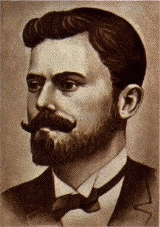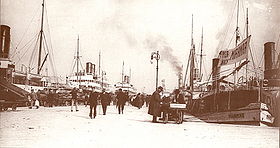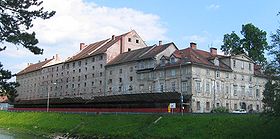
Dragotin Kette
Encyclopedia
Dragotin Kette was a Slovene Impressionist
and Neo-Romantic
poet
. Together with Josip Murn, Ivan Cankar
and Oton Župančič
, he is considered as the beginner of modernism
in Slovene literature.
n town of Ilirska Bistrica
, in what was then part of the Austro-Hungarian Empire (now in Slovenia
). His father was a teacher and a choirmaster; his mother died when he was four years old. In 1898, he enrolled to the State Gymnasium
in Ljubljana
. In 1894, his maternal uncle, Janez Valenčič, who was paying for Kette's scholarship, withdrew his financial support, because Kette published some satyric verses on the bishop of Ljubljana
Jakob Missia in the student paper. Kette had to continue his studies in Novo mesto
, where he successfully passed his matura
exam in 1898] In Novo mesto, he fell in love with the daughter of the district judge, Angela Smola, to whom he dedicated his most beautiful poems.
During his high school years, he became acquainted with the young authors Ivan Cankar, Oton Župančič and Josip Murn, who were introducing modernist elements in Slovene literature.
After finishing his high school studies, Kette was drafted by the Austro-Hungarian Army
and sent to Trieste
. In Trieste, he fell sick with tuberculosis
and returned to Ljubljana, where he settled in a small room in a slum building on the banks of the river Ljubljanica
(an abandoned sugar factory, known as Cukrarna). He died there in 1899, at the age of 23. In the last weeks of his life, he was catered by his close friend Josip Murn, who would die two years later on the same bed.
He is buried in the Žale
cemetery in the Bežigrad
district of Ljubljana.

 Kette's poetry was influenced mostly by Slovene folk songs and by classical authors such as Goethe, Heine
Kette's poetry was influenced mostly by Slovene folk songs and by classical authors such as Goethe, Heine
and Prešeren. Through his friends, he became acquainted with French
symbolist
and decadentist
poets, particularly Paul Verlaine
and Maurice Maeterlinck
, but rejected them. He chose instead an original approach, similar to neo-romantic trends in fin-de-siecle Europe.
His most famous works include the lyrical impressionist poem Na trgu ("On the Square"), and a cycle of eight poems entitled Na Molu San Carlo ("On Saint Charles Pier") written in Trieste.
Kette is also famous as the author of popular children literature. He wrote around 25 tales and poems for children, with the most famous being, "The Tale of the Dressmaker and the Little Scissors", "The Sultan and the Doggy" and "The Bee and the Bumblebee". His children literature is still widely popular and it has been translated into German
, Czech
, Serbian
, Croatian
, Macedonian
and Hungarian
.
, participated in Kette's funeral. His collected poems were published in 1900, edited by Anton Aškerc
, who was then considered the most important author in the Slovenian language, who had previously rejected Kette's poetry. Aškerc's condenscendingly patronizing preface to the edition was strongly criticized by Ivan Cankar and Oton Župančič, leding to a public dispute in which the young Slovenian writers challenged the esthetic standards of the older generations, represented by Aškerc. On the first anniversary of Kette's death, Ivan Cankar published an influential essay in his memory, which began with the words:
Kette had an important influence on future generations of Slovenian authors, such as Alojz Gradnik
, Srečko Kosovel
, Miran Jarc
, Ivan Minatti, Janez Menart
, Kajetan Kovič
and Ciril Zlobec
.
Impressionism (literature)
Influenced by the Impressionist art movement, many writers adopted a style that relied on associations. The Dutch Tachtigers explicitly tried to incorporate impressionism into their prose, poems, and other literary works...
and Neo-Romantic
Neo-romanticism
The term neo-romanticism is used to cover a variety of movements in music, painting and architecture. It has been used with reference to very late 19th century and early 20th century composers such as Gustav Mahler particularly by Carl Dahlhaus who uses it as synonymous with late Romanticism...
poet
Poet
A poet is a person who writes poetry. A poet's work can be literal, meaning that his work is derived from a specific event, or metaphorical, meaning that his work can take on many meanings and forms. Poets have existed since antiquity, in nearly all languages, and have produced works that vary...
. Together with Josip Murn, Ivan Cankar
Ivan Cankar
Ivan Cankar was a Slovene writer, playwright, essayist, poet and political activist. Together with Oton Župančič, Dragotin Kette, and Josip Murn, he is considered as the beginner of modernism in Slovene literature...
and Oton Župančič
Oton Župancic
Oton Župančič was a Slovene poet, translator and playwright.Župančič is regarded, alongside Ivan Cankar, Dragotin Kette and Josip Murn, as the beginner of modernism in Slovenian literature...
, he is considered as the beginner of modernism
Modernism
Modernism, in its broadest definition, is modern thought, character, or practice. More specifically, the term describes the modernist movement, its set of cultural tendencies and array of associated cultural movements, originally arising from wide-scale and far-reaching changes to Western society...
in Slovene literature.
Life
Kette was born in a small village of Prem near the CarniolaCarniola
Carniola was a historical region that comprised parts of what is now Slovenia. As part of Austria-Hungary, the region was a crown land officially known as the Duchy of Carniola until 1918. In 1849, the region was subdivided into Upper Carniola, Lower Carniola, and Inner Carniola...
n town of Ilirska Bistrica
Ilirska Bistrica
Ilirska Bistrica is a town and a municipality in Slovenia. It belongs to the traditional region of Primorska.The town of Ilirska Bistrica is the major economic centre of the district of the same name...
, in what was then part of the Austro-Hungarian Empire (now in Slovenia
Slovenia
Slovenia , officially the Republic of Slovenia , is a country in Central and Southeastern Europe touching the Alps and bordering the Mediterranean. Slovenia borders Italy to the west, Croatia to the south and east, Hungary to the northeast, and Austria to the north, and also has a small portion of...
). His father was a teacher and a choirmaster; his mother died when he was four years old. In 1898, he enrolled to the State Gymnasium
Gymnasium (school)
A gymnasium is a type of school providing secondary education in some parts of Europe, comparable to English grammar schools or sixth form colleges and U.S. college preparatory high schools. The word γυμνάσιον was used in Ancient Greece, meaning a locality for both physical and intellectual...
in Ljubljana
Ljubljana
Ljubljana is the capital of Slovenia and its largest city. It is the centre of the City Municipality of Ljubljana. It is located in the centre of the country in the Ljubljana Basin, and is a mid-sized city of some 270,000 inhabitants...
. In 1894, his maternal uncle, Janez Valenčič, who was paying for Kette's scholarship, withdrew his financial support, because Kette published some satyric verses on the bishop of Ljubljana
Roman Catholic Archdiocese of Ljubljana
The Roman Catholic Metropolitan Archdiocese of Ljubljana is an ecclesiastical territory or diocese of the Roman Catholic Church in Slovenia. It was erected as the Diocese of Ljubljana by Pope Eugene IV on 6 December 1461 and was immediately subject to the Holy See from its creation until erected...
Jakob Missia in the student paper. Kette had to continue his studies in Novo mesto
Novo Mesto
Novo Mesto is a city and municipality in southeastern Slovenia, close to the border with Croatia. The town is traditionally considered the economic and cultural centre of the historic Lower Carniola region.-Geography:...
, where he successfully passed his matura
Matura
Matura or a similar term is the common name for the high-school leaving exam or "maturity exam" in various countries, including Albania, Austria, Bosnia and Herzegovina, Bulgaria, Croatia, the Czech Republic, Hungary, Italy, Kosovo, Liechtenstein, Macedonia, Montenegro, Poland, Serbia,...
exam in 1898] In Novo mesto, he fell in love with the daughter of the district judge, Angela Smola, to whom he dedicated his most beautiful poems.
During his high school years, he became acquainted with the young authors Ivan Cankar, Oton Župančič and Josip Murn, who were introducing modernist elements in Slovene literature.
After finishing his high school studies, Kette was drafted by the Austro-Hungarian Army
Austro-Hungarian Army
The Austro-Hungarian Army was the ground force of the Austro-Hungarian Dual Monarchy from 1867 to 1918. It was composed of three parts: the joint army , the Austrian Landwehr , and the Hungarian Honvédség .In the wake of fighting between the...
and sent to Trieste
Trieste
Trieste is a city and seaport in northeastern Italy. It is situated towards the end of a narrow strip of land lying between the Adriatic Sea and Italy's border with Slovenia, which lies almost immediately south and east of the city...
. In Trieste, he fell sick with tuberculosis
Tuberculosis
Tuberculosis, MTB, or TB is a common, and in many cases lethal, infectious disease caused by various strains of mycobacteria, usually Mycobacterium tuberculosis. Tuberculosis usually attacks the lungs but can also affect other parts of the body...
and returned to Ljubljana, where he settled in a small room in a slum building on the banks of the river Ljubljanica
Ljubljanica
The Ljubljanica is a river in the southern part of Ljubljana Basin in Slovenia. The capital of Slovenia, Ljubljana, is situated on the river. The Ljubljanica rises to the south of the town Vrhnika and outflows in the Sava River about downstream from Ljubljana. Its largest affluent is Mali graben....
(an abandoned sugar factory, known as Cukrarna). He died there in 1899, at the age of 23. In the last weeks of his life, he was catered by his close friend Josip Murn, who would die two years later on the same bed.
He is buried in the Žale
Žale
Žale Central cemetery , often abbreviated to Žale, is the largest and the central cemetery in Ljubljana. It is located in the Bežigrad district and operated by the Žale Public Company.- History :...
cemetery in the Bežigrad
Bežigrad
The Bežigrad District or simply Bežigrad is a city district in the northern part of Ljubljana, the capital of Slovenia. It encompasses the area between the southern rail line to the south, the Upper Carniola rail line to the west, the highway loop to the north, and Šmartno Street and the Žale...
district of Ljubljana.
Work


Heine
Heine is a German family name. The name comes from "Heinrich" or the Hebrew "Chayyim" . When mentioned without a first name it usually refers ti the poet Heinrich Heine...
and Prešeren. Through his friends, he became acquainted with French
France
The French Republic , The French Republic , The French Republic , (commonly known as France , is a unitary semi-presidential republic in Western Europe with several overseas territories and islands located on other continents and in the Indian, Pacific, and Atlantic oceans. Metropolitan France...
symbolist
Symbolism (arts)
Symbolism was a late nineteenth-century art movement of French, Russian and Belgian origin in poetry and other arts. In literature, the style had its beginnings with the publication Les Fleurs du mal by Charles Baudelaire...
and decadentist
Decadent movement
The Decadent movement was a late 19th century artistic and literary movement of Western Europe. It flourished in France, but also had devotees in England and throughout Europe, as well as in the United States.-Overview:...
poets, particularly Paul Verlaine
Paul Verlaine
Paul-Marie Verlaine was a French poet associated with the Symbolist movement. He is considered one of the greatest representatives of the fin de siècle in international and French poetry.-Early life:...
and Maurice Maeterlinck
Maurice Maeterlinck
Maurice Polydore Marie Bernard Maeterlinck, also called Comte Maeterlinck from 1932, was a Belgian playwright, poet, and essayist who wrote in French. He was awarded the Nobel Prize in Literature in 1911. The main themes in his work are death and the meaning of life...
, but rejected them. He chose instead an original approach, similar to neo-romantic trends in fin-de-siecle Europe.
His most famous works include the lyrical impressionist poem Na trgu ("On the Square"), and a cycle of eight poems entitled Na Molu San Carlo ("On Saint Charles Pier") written in Trieste.
Kette is also famous as the author of popular children literature. He wrote around 25 tales and poems for children, with the most famous being, "The Tale of the Dressmaker and the Little Scissors", "The Sultan and the Doggy" and "The Bee and the Bumblebee". His children literature is still widely popular and it has been translated into German
German language
German is a West Germanic language, related to and classified alongside English and Dutch. With an estimated 90 – 98 million native speakers, German is one of the world's major languages and is the most widely-spoken first language in the European Union....
, Czech
Czech language
Czech is a West Slavic language with about 12 million native speakers; it is the majority language in the Czech Republic and spoken by Czechs worldwide. The language was known as Bohemian in English until the late 19th century...
, Serbian
Serbian language
Serbian is a form of Serbo-Croatian, a South Slavic language, spoken by Serbs in Serbia, Bosnia and Herzegovina, Montenegro, Croatia and neighbouring countries....
, Croatian
Croatian language
Croatian is the collective name for the standard language and dialects spoken by Croats, principally in Croatia, Bosnia and Herzegovina, the Serbian province of Vojvodina and other neighbouring countries...
, Macedonian
Macedonian language
Macedonian is a South Slavic language spoken as a first language by approximately 2–3 million people principally in the region of Macedonia but also in the Macedonian diaspora...
and Hungarian
Hungarian language
Hungarian is a Uralic language, part of the Ugric group. With some 14 million speakers, it is one of the most widely spoken non-Indo-European languages in Europe....
.
Influence and legacy
Contrary to his friend Josip Murn, Kette became an established poet already during his lifetime. His death was followed by a semi-official mourning and several public figures, such as the mayor of Ljubljana Ivan HribarIvan Hribar
Ivan Hribar was a Slovene and Yugoslav banker, politician, diplomat and journalist. At the turn of the century, he was one of the leaders of the National Progressive Party, and one of the most important figures of Slovene liberal nationalism...
, participated in Kette's funeral. His collected poems were published in 1900, edited by Anton Aškerc
Anton Aškerc
Anton Aškerc was a Slovene poet and Roman Catholic priest, best known for his epic poems.Aškerc was born into a peasant family near the town of Rimske Toplice in the Duchy of Styria, then part of the Austrian Empire . His exact birthplace is unknown because his family was on the move at the time...
, who was then considered the most important author in the Slovenian language, who had previously rejected Kette's poetry. Aškerc's condenscendingly patronizing preface to the edition was strongly criticized by Ivan Cankar and Oton Župančič, leding to a public dispute in which the young Slovenian writers challenged the esthetic standards of the older generations, represented by Aškerc. On the first anniversary of Kette's death, Ivan Cankar published an influential essay in his memory, which began with the words:
Kette had an important influence on future generations of Slovenian authors, such as Alojz Gradnik
Alojz Gradnik
Alojz Gradnik was a Slovenian poet and translator.-Life:Gradnik was born in the village of Medana in the Goriška Brda region, in what was then the Austro-Hungarian Empire and is today in the Goriška province of Slovenia. His father was a Slovene from Trieste who came from a poor working family...
, Srečko Kosovel
Srecko Kosovel
Srečko Kosovel was a Slovene expressionist poet who evolved towards avant-garde forms. Since the 1960s, Kosovel has become a poetic icon, in the league of the most prestigious Slovene literates like France Prešeren and Ivan Cankar. Together with Edvard Kocbek, he is considered as the most...
, Miran Jarc
Miran Jarc
Miran Jarc was a Slovene writer, poet, playwright and essayist.Jarc was born in the town of Črnomelj in White Carniola, in what was then Austria-Hungary in 1900. He was sent to school in Novo Mesto, and between 1918 and 1922 studied Slavic philology in Zagreb and Ljubljana, though he never...
, Ivan Minatti, Janez Menart
Janez Menart
Janez Menart has been one of the most influential and most widely sold Slovenian poets, translators and screenwriters from the first post-war generation...
, Kajetan Kovič
Kajetan Kovič
Kajetan Kovič is a Slovene poet, writer, translator and journalist. He is best known for his poems and has written several bestselling children's books....
and Ciril Zlobec
Ciril Zlobec
Ciril Zlobec is a Slovene poet, writer, translator, journalist and former politician. He is best known for his poems and has published several volumes of poetry...
.
Sources
- Ivan CankarIvan CankarIvan Cankar was a Slovene writer, playwright, essayist, poet and political activist. Together with Oton Župančič, Dragotin Kette, and Josip Murn, he is considered as the beginner of modernism in Slovene literature...
, "Dragotin Kette" in Bela krizantema (Ljubljana: Mladinska knjiga, 1966), 16-28. - Silvo Fatur, Dragotin Kette - Prem (Ilirska Bistrica: Občina, 2000).
- Matjaž Kmecl, Kette na svetli strani moderne (Ljubljana: Slavistično društvo Slovenije, 2006).
- Juraj Martinović, Poezija Dragotina Ketteja (Ljubljana: Slovenska maticaSlovenska maticaSlovenska matica , also known as Matica slovenska, is the second-oldest publishing house in Slovenia, founded in the 19th century as an institution for the scholarly and cultural progress of Slovenes...
, 1976). - Janez Mušič, Dragotin Kette (Ljubljana: Mladika, 1993).

